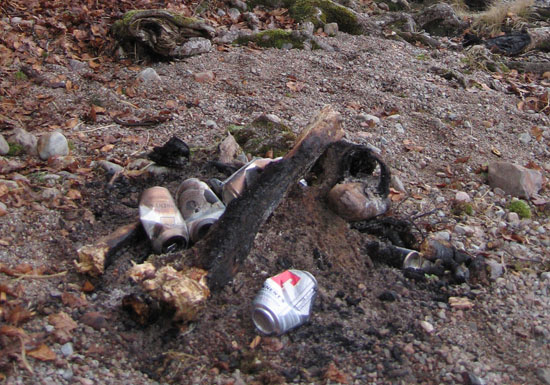
How to Leave No Trace of Your Campfire
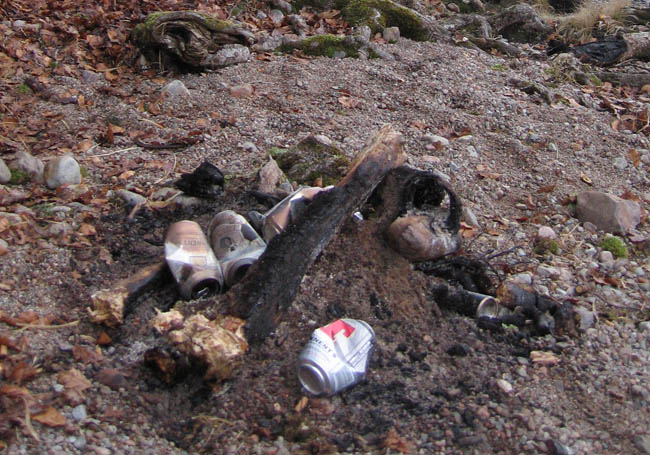
For me, leaving as little trace of my presence as possible is an important part of bushcraft. In leaving no trace, you show respect for the environment and respect for other visitors who may come after you.
In particular, if you have a campfire, it is important to ensure you leave the site safe, clean, tidy and as you would wish to find it.
In my travels, I have found many sites of campfires in a state that they needn’t have been left. I think a lot of the time it is due to people knowing no better. There is also a small minority who just don’t care. Therefore, it’s even more important that those of us that do care do our best to leave places as we find them, to avoid campers, hikers, canoeists and bushcraft and survival skills enthusiasts from getting a bad name. It’s also imperative that we do our best to show others best practice.

Why Should We Leave No Trace Of A Fire?
A smouldering fire is a threat to the environment
It’s not just about leaving a campsite clean and tidy, leaving making sure we leave the environment safe from our fire is paramount. Before leaving a campsite where we have had a fire, we must make sure that there is no risk of the fire spreading into the wider local environment after we have left. More often than not this means making sure the fire is well and truly dead. And this normally means dousing with water. With this in mind, choose your campsite well, with water relatively close to hand if possible.
Also think ahead – the bigger the fire you have, the more water you will need to make it safe. When I teach bushcraft courses, people are always surprised at how much water they need to cool the ground under a relatively modest fire site. We are not only concerned about embers blowing on the wind but we should also be concerned about the remnants of a fire smouldering in the ground, within root systems of trees. This is a particular risk with coniferous trees.
An obvious fire site is, well, obvious…
An obvious fire site encourages others to have fires in the same place. Increased footfall and tent pitching in a particular area may cause more localised damage to vegetation than someone pitching camp in another, random spot. People are lazy – especially at the end of the day – and go with the easiest option.
An obvious fire site disturbs the sense of wilderness and exploration. There is an added thrill to being in wild places when you feel they are untouched. Even if you are not so far from others, this illusion of remoteness can be burst by obvious and unnecessary signs of others having camped before you.
An exception to this is when there are specified camping sites (say in a national park) where the authority that looks after the land wants people to have only one campfire area on a campsite. This can be for various reasons such as not having a proliferation of mess, or causing damage to the ground or fragile rock. In particular, park authorities often want to encourage people to have a fire on a rocky area where there is no danger of the fire spreading through tree root systems.
Even so, there is no reason to leave an established fire circle full of mess such as inflammable rubbish and half-burned logs. It’s unsightly and disrespectful to the next user. Also, once wetted by rain, half-burned charred logs are second-rate firewood at best.
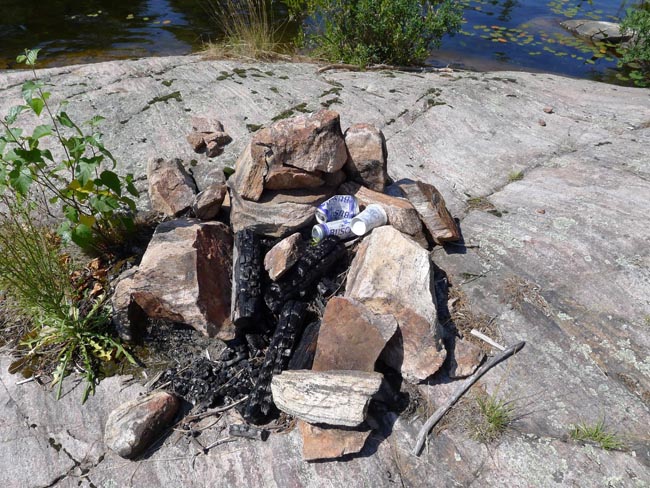
Cleaning a fire site helps eliminate litter
I really have no idea why people feel the need to leave tin cans in campfires. There is no logic to it. If you pack it in, you should pack it out. Stamp on the can and put it in a rubbish bag to take home with you.
It’s not just the obvious cans we need to take home either. Tin foil is a scourge and isn’t necessary for good campfire cookery. If you disagree – tell me how our ancestors coped for millions of years before we discovered a use for bauxite? Exactly.
Even those of you with the best intentions can be caught out these days, though. Many packets, sachets and the like, have tiny amounts of foil on the inside. When this is burned in the fire, the foil is left behind. Tidying up your campfire after you have used it ensures you pick up any foil which may have been deposited in this way.
How Do You Leave No Trace Of Your Campfire?
A really important but often overlooked piece of advice is to think ahead:
- Make sure you clear the ground before you light your fire if necessary. See this article on how to light a campfire.
- Think about how much fuel and of what type you really need to achieve your goals – cooking, warmth, morale, a focal point for the camp, etc.
- Think about how long it will be until you are leaving; practice judging your fuel so that there is nothing but ashes by the time you want to break camp. If your fire is still full of half-burned logs, you got it wrong.
- When it comes to clearing up and making your fire safe, this task normally requires water. Don’t camp miles away from an easy source.
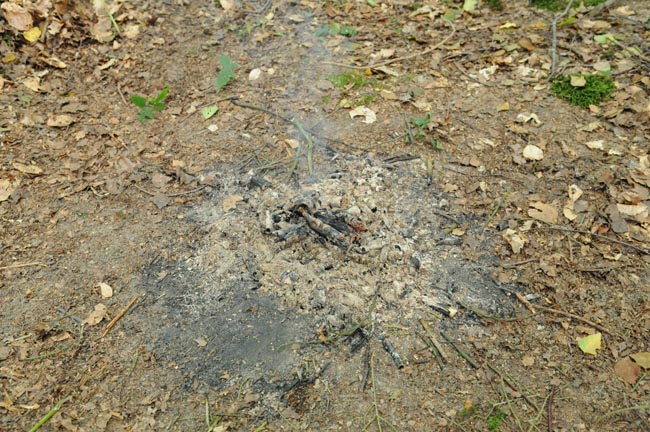
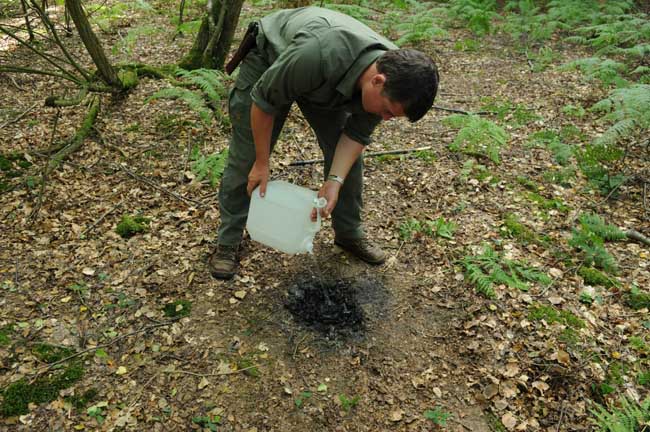

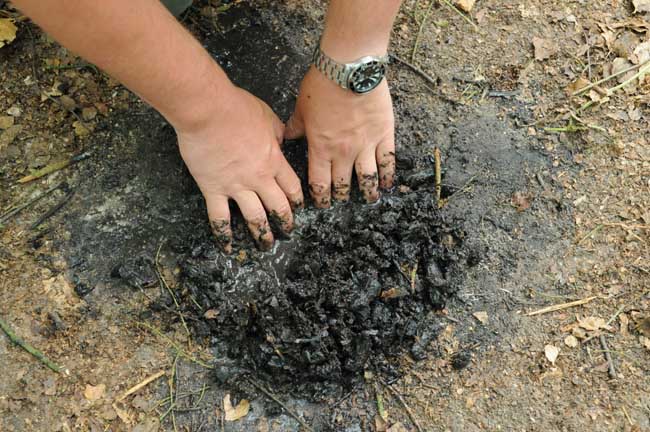
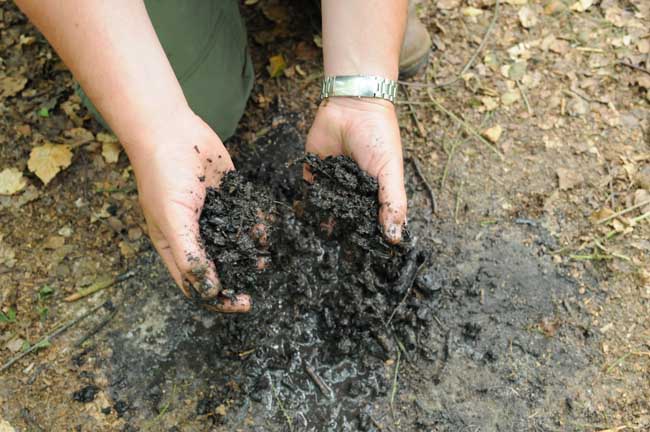

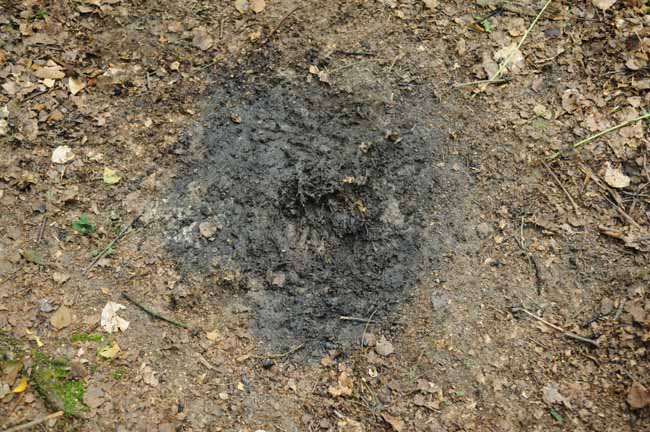

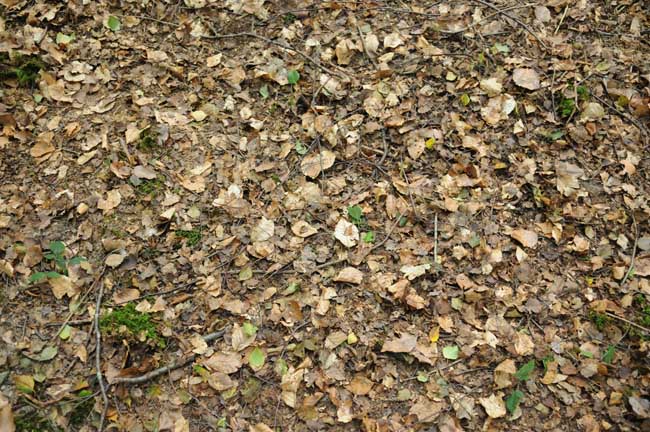

Having a campfire is an elemental thing. For many it is an integral part of camping and the outdoors experience. Those of us who do choose to have a fire in the great outdoors must do so responsibly. We should understand how to leave the site of a campfire safe and clean. We should always leave a campsite as we would wish to find it and this certainly includes the fire site.
Please let me and other readers know any extra tips or tricks for tidying up after you that you use.
78 thoughts on “How to Leave No Trace of Your Campfire”
This has to be learned from the start and in every beginners course !
The “Leave no trace” principle has given the bushcrafter a positive position and not being counted as the next rubbish making wilderniss tourist.
Maybe people should look into the makings of a Swedish Torch. At least with that they have a fire and something to cook with but it is only one log and can be burned away with a smaller area to clean up.
That or people should think more as to what they are doing.
In general, I agree with everything Paul has said and this is what I practice when I go out into the woods. But there is just one thing that troubles me: ‘an obvious fire site disturbs the sense of wilderness and exploration.’ This is a statement of values, which shows that we bring more than just kit and knowledge with us when we go outdoors. Wilderness, it seems, must always be – or appear to be – untouched by humans.
This idea of nature as only perfect when untouched has had some negative effects; for example, the on-going struggle between many conservationists and supporters of indigenous people’s rights. It also gets in the way of seeing our proper place in nature and acting more sustainably in all our activities. Needing to (quite rightly) reemphasise respect for the environment shows how far we still are, as a society, from this path.
I doubt our ancestors would have looked at things this way. Coming across the remains of a campsite must have been a powerful experience for them, possibly full of delight or maybe foreboding. In bushcraft, we often look to learn from the past. This doesn’t always mean adopting the practices of the past, but it can be instructive to linger over the differences.
I think litter is disgusting and uncontrolled fires can be devastating – I want to prevent them both. There are also a lot more of us these days and we need to be mindful of our cumulative impact. But I would also like us to get a point where we can feel a warm glow from cold embers as a connection to the environment, our past and a community of respectful nature lovers. I would be happy to come across fire sites if I never saw litter.
I totally agree,
I love Paul blog but I think this is British ethos mixed with fear to prohibition. A fire scar covered by leaves only make you feel good as with the next gust the scar will be visible anyway. Even worst, the next camper will start a fire somewhere else, few metres from there.
I am aware in other parts of the world the idea is not to leave not trace but to leave the campsite in order for the next visitor.
You usually do a circle of stone to avoid the fire spreading so the fire is always made in the same place and you do not keep burning different spots of soil. You also leave logs protected if you can for the next one. If you manage to move some big trees for sitting you also leave them next to the “firepit” for the next explorer to enjoy them.
I love wild places. Every time that I used to walk in a bit remote place it disappointed me to see a path. So silly! Later on I went to Botswana… in the middle of the dessert there are paths everywhere! Why? Because animals do paths, and shit, and break branches, and move the earth. For me it is silly to think that no one has walked a place before. We have been everywhere. I think the idea is to do as little impact as possible. I think it is a waste of effort and a bit of hypocrisy* to leave the place like if you have not been there.
*hypocrisy because there is nothing wild in UK. UK has been massively modified, abused, exploited, deforested, etc so we just are conserving something that has been altered and quite often degraded. I think we are not improving it leaving no trace, we just clean our conscience.
Just to clarify. I am totally against leaving rubbish but I wont consider a fire pit made of stone with some burned wood rubbish.
Hi Fernando,
You raise an interesting philosophical point regarding clearing conscience vs clearing up after you.
While I agree with you to an extent, I feel I should correct a couple of points.
Putting stones around a fire does not stop a fire from spreading. While it may stop surface material such as leaf litter from being scorched and set off into a slow smoulder, it does not stop peaty ground from catching light, nor does a ring of stones prevent root systems from catching light.
The process described in the article above is not just about leaving no visible trace of the fire. More importantly, it’s about leaving no physical trace of combustion. You have to make sure the ground is not alight and the fire will not emerge after you have left the site.
I do agree, however, that in areas where you wish fires to be contained to one place, then a stone circle or established fire area can be advantageous. This is often the case in provincial parks in Ontario for example, where safe areas for fires have been established and park authorities wish people to contain the fire to those spots.
As for whether anything in the UK is wild or not, this is not the main reason for clearing up after you or not. Personally, I find most fire sites that are left uncleared to be generally messy and unsightly. It’s an aesthetic judgement to an extent but it’s also about respect (as well as safety as discussed in the previous paragraph).
Statistically most people will not camp in the same place. Leaving a visible fire site will induce more people to camp in the same spots. This puts pressure on the local environment, both in terms of diminished dead wood as well as flattening, damage and erosion due to increased footfall and tent/bivvy footprints in the area. People are inherently lazy. If you remove the clues as to where to camp, they have to make their own decisions…
Warm regards,
Paul
Thanks Paul,
I am sorry I never thanked you for your comprehensive reply.
I have been appliing the techniques that you explain in the video and to be honest it not only make sense but also you feel quite proud after leaving a place nearly exactly as when you arrived.
Also I have seen some “wild campsites” around ours and as you say these had more trash around and the environmental impact was quite notorious.
Kind Regards,
Fernando
No worries Fernando. Good to hear from you and I’m glad this has been useful.
Warm regards,
Paul
I feel it’s important to note ,and maybe implied but not explicitly stated in you latest post here Paul, that most wild camping is also done on land owned by someone else so LNT practice is best both because of respect for the land owner and to prevent access issues in the future.
Thank you for the information.
I live in an area where, although there are no officially regulated fire places, we do try to contain our fires to a limited amount of well used ones. Sometimes you run across an area littered with fireplaces, and it doesn’t really impress me I can say, but having a few very visible fire sites available helps those who doesn’t really care limit themselves to just a few places. I often end up picking up their litter, but at least it isn’t everywhere. And often find some other less used place to camp where we *do* see to that there isn’t much trace of us.
The practices you show only work on deep soil, though, and we often camp at blueberry pine hills where you’ll scorch the ground down to the bare rock and then won’t find much to cover it with. So if we didn’t bring some kind of burner with us, we’ll use one of the established sites.
Leave nothing but your thanks!
With the number of people per acre in Britain having a fire on the ground at all is uncceptable. You are sterilizing the soil , altering it’s chemistry, destoying mycellium and bulbs and eggs and grubs,wood ash is a potent alkaline and most soil is acid so wetting it and burying it are only hiding it from human sight and that is not the concept of leaving no trace.
Great article Paul… it pays to remind ourselves about the basics at times :o)
As for voting for your blog… done that and answered a couple more about best instructor and bushcraft school ;o)
Good article (as ever), and an important topic which I’m glad you have covered.
The point about bits of foil left from burning packaging is well made. Do you have any general observations or tips about what should or shouldn’t be disposed of in the fire?
I routinely clear up after people who leave messy fire-sites in woodland near my home. There is no excuse for leaving any mess behind ourselves, quite apart from the terrible danger posed by fires which have not been properly extinguished. I’m frequently amazed by the rubbish left behind by thoughtless hikers and campers. Why do these people bother to hike into wild and beautiful places only to despoil the very place they are visiting?
James makes an interesting point about our ancestors, but our ancestors only carried natural materials, not things which take years to decay, or will remain in situ virtually forever. Added to that the population density was much lower in our Mesolithic past so the impact would be much lower. The cultural differences in how we perceive these issues compared to our ancestors or with other indigenous people is of course significant, but I think we are all capable of understanding the ‘Leave no Trace’ ethic and I can’t think of anybody who could convincingly argue against it.
Paul rightly flags up our duty of care; we won’t be trusted to wild camp if we don’t take our responsibilities seriously. Just look at the bylaw now banning wild camping along the east side of Loch Lomond as a direct result of thoughtless or lazy folk leaving rubbish and fire-scars. See http://www.bbc.co.uk/news/uk-scotland-tayside-central-12698722
By taking a few minutes to clear up our fires and campsites carefully, and by thinking about what we’re burning, we are investing in our own future rights. Why wouldn’t we want to do that. As is so often the case education and awareness is the key, which is why articles like this are so important in encouraging best practice in our community.
Education is the key to healthy natural lands. Thanks for the great post and phenomenal blog!
Lets all remember the tenet all good bushcrafters stick to, “Take only memories, Leave only footprints”.
Great article Paul on a subject that is one of my pet hates,i only wish some of the people guilty of this could read your article. Thanks.
It should be lawful to disembowel individuals who leave fire and rubbish like your opening pic with a spoon.
It should be legal to disembowel people who advocate killing someone just because they left litter on the ground.
Thanks for your input Gino.
Oh, you’d be busy. Very busy, if you lived near any major town.
I think it’s almost a rite of passage: You have to learn to really appreciate nature before you start caring for it and protecting it. So you start off as a bumbling idiot by default, if you don’t have anyone teaching you while growing up. And most people don’t have that nowadays, sadly.
It should be lawful to disembowel individuals who leave fire sites and rubbish like your opening pic with a spoon.
This is a excellent articale Paul.
Can’t tell you how many times ive come across a camp fire like these, it pisses me off.
But, i try to clean them up as best i can. And i get 10 cents each for beer cans, lol.
” LEAVE NO TRACE” 🙂 Cheers
thanks again paul for another well put together and important article.a good clean up job emphasizes the magical effect of a campfire and visually returns nature to its undisturbed state.i can see the point james is making about mirroring our mesolithic ancestors but like it or not we are today in a different reality .as steve pointed out the population density difference is enormous and also these days we are unfortunately only left with pockets instead of countries of untouched landscape. to give us a sense of those times i think it best to keep it so for all to appreciate
The campfire is a very emotive thing and a great comfort to those travelling or living off the land, i love them but I always go for a small contained fire off the ground as I strongly believe that the fire scars are not welcome, in the pockets of wilderness we have left.
So this article goes a long way to address through education the idiots who believe that they need a large fire directly upon the ground. The ground takes years to recover from a fire. where as a small contained fire that uses small stuff keeps me warm provides tea, food and companionship and leave no fire scar. The last thing I do before leaving camp is to scatter the cold wet ashes over a large area to aviod a concentration in popular areas. Pack my fire pit into its bag and away I go without anyone knowing I have been there. So by not using logs or larger branches I leave no half burned wood and no trace of a fire at all to the unknowing.
So well done Paul keep the leave no trace articles comming.
Superb article Paul.
Surely ‘Leave No Trace’ should be central to all actvities outdoors… Unfortunately ,especially in the UK and the States it most certainly is not. Folks seem to forget that nature is something to revere and show respect . Leaving no trace , taking just what you need and leaving nature’s resources unspoilt should be both an attitude and habit.
I am sure all of the people reading Paul’s articles and this blog are completely ‘on side’. It is most certainly our job to educate all those we come in contact with.
Or perhaps Mr Clarkson would have some suitable punishment ‘up his sleeve’ for these ‘offenders’ !
Good Article Paul
(Great minds think alike LOL)
Leaving a fire scar in the wilds is bad enough, but leaving tin cans and rubbish!!!!
some people should be made to picnic at the local tip not in the beautiful great outdoors!!!!!
Good article
Fire scars- learning point.
Isn’t it possible to use stones as a layer to protect the ground , when possible…to lift the fire off the ground.
I think you should always lift a fire off the ground. But be careful of the stones you use as porous stone could explode when heated up.
Ground fires have dangers other than fire scars, for example a fire on peat could leave a ground fire burning for years and destroy the wilderness you sought out.
I was told this although i doubt its origins ‘Red man makes small fire keeps warm, white man make big fire keeps warm getting wood’
Great article.
Theres nothing worse than some bosso leaving the remains of a fire with all the other rubbish piled in it.
Fortunately most people have more sense, but your article explains the whole procedure excellently.
many thanks
It saddens me greatly when I walk through a beautiful piece of woodland and come across half burnt fires strewn with beer cans and plastic wrappers. To me this demonstrates a total lack of respect and understanding of both nature and other human beings. As human beings we have a duty of care towards this planet and all life upon it. After all, are we not children of nature our selves.
Many thanks to Bean. I like that little saying. Good humour tends to be born from truth.
I have been waiting for something like this, thanks. I read a l lot of the comments and most had a similar theme. What I find interesting is there are hundreds of You/tube videos on starting and maintaining fires, but I have seen only ONE that showed how to clean up after. It was done basically like Paul just showed. Thanks Paul for the information.
My pleasure Bruce. Thanks for your comments.
Warm regards,
Paul
You would think, even a form of this, would be common knowledge. It should be taught in schools, if it isn’t then what the hell are schools for?
Great work as always Mr. Kirtley.
I am training to be a forest school practitioner, check it out! We are getting there. I’m on this site because I will have to teach this to children. The Scout and Guide movements also teach it.
Hi Jenny, all the best with your Forest School training.
Warm regards,
Paul
Hi,
An extensive article. I think you should be advocating the Leave No Trace ethic of ‘mound fire’s’. I ran two LNT workshops yesterday for expedition leaders. If you use a plastic bag for life, you can use it to carry the soil. Mound fires are very simple and you will have a trowel for human waste anyway (even on a day trip).
Here is an official LNT video showing Mound fire technique. http://youtu.be/P1JSzgBEVhk
Nick
Leave No Trace Trainer
I learned how to do this in the Boy Scouts, back in the 70s. Plus I was raised in a Outdoorsman family, from very young. I never understood the reason for leaving trash, or even think of leaving a fire smoldering. It’s a shame that there are those that just don’t care. PEOPLE…What can you do.
Any tips on how to choose the right amount of wood so the fire burns down to ashes? I usually have a massive pile of charcoal left over because I like having a steady fire. Also how do you keep a fire small?
If you have any thoughts or advice, please let me know. Thanks
It depends on the surroundings and it depends on what you want to achieve with your fire. Cooking pit? Just a social fire? The optimum I know if you want a concealed fire that is hot and a fire you can get rid of later easily are fire pit constructions like e.g. the Dakota fire pit.
Level of smoke and duration of fire depends on the woods you are using.
But I’m sure Paul has better tips for you. I’ll leave it to the expert.
I’m no master at this, but one thing I’ve learned is to have an excess of small firewood, and put it on towards the end to help the larger pieces burn through. I like to have a bit of a blazing fire after cooking my food at any rate, so I guess it works both ways.
I think that’s something everyone used to learn when I grew up. (’74 German construction)
If you go to a wild place, you leave it as you found it. So it stays wild and the next can enjoy it.
It is kind of sad that today we need blog articles to explain that. But I agree – I see the same signs on my own treks. Everywhere!
One of the first things I learned as a young Boy Scout (although it was not emphasized or even mentioned in my later Scouting years for some unknown reason) was to leave two pieces of green wood crossed as an “X” where your campfire was when you leave. Should there be a forest fire in the area afterwards, you can prove that it was not your fire that caused it as the undersides of your X will remain green and unburned.
Hi Dale,
That’s interesting. I can see the logic but it’s also sad to see backside-covering and litigation-driven behaviour have followed us into the woods…
Warm regards,
Paul
Hi Paul
Fantastic article. I myself have always been an avid bushcrafter, I have work as a Safari guide in Southern Africa for some years and now I am guiding in the Arctic Circle. Whenever I make a fire I do 2 things, I chop my wood nice and small to get the fire started quick and depending on the occasion I will chop all other pieces accordingly so that they will burn down to ashes, I also avoid artificial firelighters, I use bark. The other thing I do is I never make a fire on the ground, I carry a fire bowl with me wherever I go camping, it straps nicely to my backpack or in my sled and weights a few kgs. This way I avoid burning the ground at all and effectively leave zero trace on the ground. I remember numorous in Africa where a fast burning smokeless fire or even the fire bowl saved my life from surrounding threats. Great advice I have learnt as a boy, do not make a fire unless you really need/are ready for it. Always be prepared
Regards
Hein
Hi,
Just been reading your blog found it really useful and interesting. Especially the “no trace ” debate.
My observations are from Wales, Llanberis to be precise. Lots of people visit this place as it is a mecca for outdoor enthusiasts. Down at the lake where the canoeists make fire I have seen that they revisit there own camp fire area. As you walk along the banks of the lagoons you can see flat slabs of slate laid over established hearths. The areas are clear of rubbish and each person knows where their hearth is and they protect it so they can revisit it without having to find a new site. A compromise between the two discussion points raised between “no trace” and an “established site” that gets over used an abused. The hearths were not obvious. I agree with one of your bloggers that actually it felt quite nice to come across hearths. Especially when they are looked after and the users show respect.
An interesting discussion. May be as time goes by and more and more people reconnect with nature we will establish a pattern that is acceptable for all.
Love the site Paul really useful information and great responses.
Glad you found the discussion here interesting. Thanks for adding to it with your comments.
Thanks also for your kind words about this site.
Warm regards,
Paul
I think that most camping/hiking people know that they should not throw beer tins in campfires. In my experience its the young people going outdoor that dont know/understand and the older that don’t care. Even in countries/areas that should know better like Sweden, Norway, Canada. I’m affraid to mention that I used to pull out twice the garbage I myself brought to the place, but lately I’m getting sick and tired of cleaning up other peoples mess.. I do that for a living and going outdoors makes me want to have peace and quiet. How do I set myself again to clean up german candy wrappers, polish soda cans, dutch tissues and uk beer cans?
Wow! Such awesome tips in regard to a campfire, I love campfire in different places, I remember there were awesome days when I’d first time camping for the fun of it and it was fantastic, I glad to have a blog to accompany me in my quest.
Glad you liked it Marty.
Thanks for sharing this helpful information. You are inspiring me to a campfire in winter. I love camping in different places. But I was wondering how it is with camping in winter. Actually, I got a lot of information from your blog which you have written your blog. Review this article my confusion is clear, Thanks.
Hi Sebastien, thanks for your comments. I’m happy my blog has been useful to you and also providing some inspiration to try new skills and experiences. If you try the fire in winter, let me know how it works.
Warm regards,
Paul
I am so grateful I found your post. You’ve really covered up almost all the possible tips that a beginner should follow to make a perfect campfire. My partner and I have been thinking of camping soon. Actually, I got a lot of information from your blog which can make our amping much more relaxing and enjoyable. Thanks.
Thanks Laura. I’m glad you found this and other articles here a useful exposition of campfire skills.
Warm regards,
Paul
As always great informative article Paul.Good point about digging holes into the ground to allow water to seep through.
I shall do that besides what i normally do, to leave no trace.
Thanks Andy. I’m glad this was useful. All the best, Paul
Thanks Paul, already practicing these methods, being ex Infantry we had other reasons for leaving no trace but good skills stay with you for a lifetime. Brilliant Blogs thank you
Great reminder of the basics, Paul.
Really enjoying your emails during the pandemic – thanks for sharing them and good luck with the coming season after all the current challenges and restrictions are over.
This is the types of things people should know, not only while camping, but on the beaches, parks and streets.
I do agree with all the ideas you have introduced in your post.
They are really convincing and can definitely work.
Still, the posts are too quick for newbies. May you please prolong them
a little from next time? Thank you for the post.
Thanks designed for sharing such a pleasant idea, post
is pleasant, thats why i have read it completely
What i don’t understood is in truth how you are not
really much more well-favored than you might be right now.
You’re very intelligent. You know therefore significantly on the subject
of this matter, produced me personally imagine it from
a lot of various angles. Its like women and men don’t seem to be involved until it’s something to
do with Lady gaga! Your own stuffs great. Always maintain it up!
An interesting discussion is worth comment. I believe that you ought to write more on this topic, it
may not be a taboo matter but generally people don’t speak about such subjects.
To the next! Many thanks!!
Aw, this was an exceptionally nice post. Finding the time and actual effort to create a superb article…
but what can I say… I procrastinate a whole lot and
don’t seem to get nearly anything done.
Hello colleagues, how is everything, and what you wish for to say regarding this paragraph, in my view its
in fact remarkable for me.
making a portable wood stove isn’t hard at all, all you need is a old metal tin (min 1L), cut out a hole at the bottom and them poke holes around the whole tin.
You can make a fire platform with some wire fabric and a simple stick frame.
Or even make a Swedish Torch by bundling
felled sticks and branches together in a cone shape if you can’t\aren’t allowed get a log cut.
There’s far more ways to have a fire other than the standard destructive ground fire and it’s a core skill for bushcraft.
Know your land and know your risks.
Paul,
So much enjoy your posts and introductory vids as well as comments of others. I am brand new to bush crafting and extended camping. I’m not even sure I am using the right wording regarding the nomenclature. We are starting late (76) with the “crafts” etc. With permission, I have access to private wooded areas near my home and harvesting of resources is permitted in designated areas – mainly slash pines and life oaks trees, no water. We prefer tarp and hammocks to save our “backs”. County “regs” do apply and are followed earnestly. Since I’m retired my wife and I enjoy the outdoors and want to make our camping experience as enjoyable as possible which means we want to learn and accomplish our skills correctly. We want to go to the next level rather than just picnicking for a day. We look forward to your vids as we get started as well as any other suggestions you might have for us “Ole Timers” No apologies 🙂
Thank you! Side bar: Can “doused coals” be dried out and use to hold a spark much like “charcloth”? You friend in Texas.
Let me know Lindsay’s Vapors ecig shop in 1095 Patton Avenue sells e-juice manufactured by PHIX? I have emailed them at raginvapes@gmail.com
There are two sorts of people, those that clear up after the others. Disembowelling with a blunt spoon may be a satisfying idea but is not only unkind and illegal but makes a mess ! I have always tried to leave no trace of my fires but never thought of making holes to pour water in so thanks for that tip. I do enjoy your work, it just makes me wish I had got into bushcraft much earlier but the pleasure of having so much more to learn is rejuvenating. Thank you Paul
Thanks Mr. Kirtley for the good advice, in my youth I was bit less considerate, but think more along your line of leaving no trace and being more respectful of nature and of others.
I have made traceless fires in turf by cutting a large H and peeling back the two sides like a book.
Once it’s cold, take out any lumps of unburned material, dig the ash into underlying soil, then replace the turf sides like closing a book.
In hot weather, repay the turf with a good watering, then be on your way with no damage done.
You said: “once wetted by rain, half-burned charred logs are second-rate firewood at best.”
Why is it so?
Thank you
Hi Barb, well simply because it is wet and wet wood does not burn well. Charred wood in particular soaks up a good amount of water.
Warm regards,
Paul
Paul, thank you for including Leave No Trace in your Fire Craft series. Extinguishing a Campfire correctly is a top Bush skill folks must practice, learn, and apply in their outdoor camping. And you’ve done a fine job explaining it in great detail. As you say, an overnight warming fire can take time to completely make it dead to the touch. So without going on and on, I just want to say as a fellow outdoors educator good stuff!
Hi Mark,
Thanks for reaching out and letting me know you appreciate this article.
Warm regards,
Paul
Leave nothing behind but bubbles and take nothing but memories, embracing the ethos of bushcraft and preserving the wilderness for future generations
Bubbles?
Totally extinguishing and clearing up the remains of a large, long-burning fire is definiftely far swifter after consuming a packet of cookies (at the end of the Interemediate week lol). Some interesting points on here about the differing cultural/national views on ‘established’ fire areas but as you say it’s not just about the visual side of things. Atb Andy